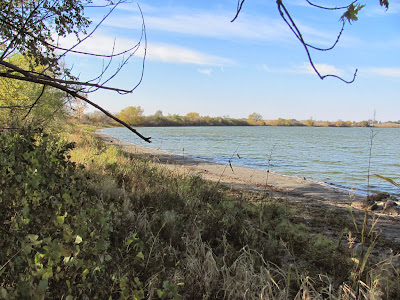People have often confused Loss Lake with Lost Lake, both
along Highway 19 in northwestern Minnehaha County, South Dakota. Loss Lake is
about 5 miles south of Humboldt, and Lost Lake is about 2.5 miles north of
Humboldt, both located on the east side of the highway.
 |
| Jay Heath and Dave Finck on Lost Lake, SD |
While I have often visited Loss Lake, today was my first
visit to Lost Lake. Lost Lake is
very secluded and requires a passage along rough roads with little
signage. Dave Finck, DeDa Odekirk
and I left Sioux Falls this morning in Dave’s van and trailer with three kayaks
and one of his Kevlar Wenonah canoes, driving west along Interstate 90 to the
Humboldt exit.
From there we drove
north on Highway 19 to 256th Street and continued east to 458th
Avenue where we turned north and then soon turned west along a dirt track road
leading through the woods to a launching spot.
There was no signage directing us to the lake, although we
could see the path on the South Dakota Atlas and Gazetteer. GPS on a iPhone seems to give a good pathway
to the lake, Google Maps mistakes Loss for Lost Lake. The entrance to the lake
passes through a wildlife production area.
The roads around Lost Lake are pretty rough; driving on them
after a rain would probably be quite a challenge for a two-wheel drive vehicle.
Lost Lake was so named because the surrounding hills hide it
so well. The surface area of the
lake is about 163 acres, making it about 60% larger than Lake Alvin. The shape
of the lake includes an irregular shoreline with several large peninsulas. There is scattered woodland along the
shore and a very few buildings within sight. There is no evidence that the lake is frequently visited.
 |
| DeDa Odekirk on Lost Lake, SD |
We arrived at the lakeshore about 9:15 a.m. with the morning
temperature about 33 degrees, clear sunny skies, and a wind of about 17 mph.
There was no ice on the lake, but puddles along the road and in some of the
ditches were ice covered.
The wind was out of the southwest creating waves of about a
foot as we set out. It seemed to
us that a counterclockwise circuit around the lake would move us across the
wind and provide the best opportunity for a smoother cruise. Deda was in her
kayak, while Dave and I took his canoe and left our kayaks on the trailer.
We set our moving around the eastern shore and headed toward
the north bank. Along the way we
encountered a lone pelican and a few gulls. Most of the bird life, I imagine, has already left for a
warmer climate further south.
As we cruised along the northern bank and headed west, we
soon found ourselves in much calmer water and were able to move along while
watching the landscape pass. The
lake shore is turning monochromatic as the winter browning continues over the
next few weeks.
In the distance, we could see some traffic moving north and
south along Highway 19, but we were alone on the water and along the
shore. There was no sight of
anyone else in the area.
Moving into the southwestern part of the lake, we
encountered a bay of submerged trees with a few feet of decayed trunk extending
up from the muddy bottom. Obviously, the water level in the lake has risen over
the past several years and destroyed this stand of trees.
We continued along the southern shoreline in relatively calm
water. The shoreline ranged from
rocky headlands to hard packed sand.
I was able to enjoy the cruise without even getting my feet wet.
Unlike my cruise last week, this time I dressed warmly. We all had on warm jackets, hats,
gloves, and shoes. Last week, I got quite chilled; this week I was
appropriately dressed.
 |
| DeDa Odekirk Warmly Dressed for Chilly Cruise |
We were out on the lake for about an hour and fifteen
minutes today. By the time we finished, the temperature had risen to nearly 40 degrees. Lost Lake is a good
place to visit; the shape is interesting and there is good opportunity for
viewing wildlife. Of course, finding roads that lead to the lake is quite a
challenge, but perhaps the search for access is part of the adventure. I will plan on returning to Lost Lake
in the spring or summer.























































